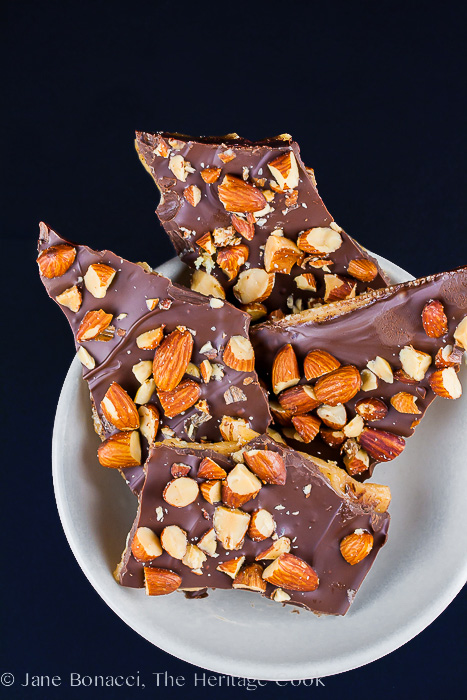
I have been making candy since before I can remember so I am one of the lucky ones that never feared it. I know to be careful of the boiling sugar (the worst burn you can get!), that sugar won’t caramelize well on humid or rainy days, to follow my instincts about how long to cook it, and how to pull taffy by hand.
Candy is fun to make, but mercurial. But there are a couple of things that will help your experience be more consistent and pleasurable. For consistent results and success every time, you need a candy thermometer. Either a candy thermometer that attaches to the pan or a good instant read that you can dip into the candy to judge temperature accurately. Even my grandmother, who rarely measured anything carefully, used a thermometer. The clip-on thermometers are not expensive and will save you hundreds of dollars in ruined ingredients if you undercook or overcook your candies.

Thermapen on the left, traditional candy thermometer on the right
A great instant read thermometer is the Thermapen. It is expensive, but I use it every day to judge the doneness of bread, meats, poultry, foods on the grill, in the oven, and on the stove, and when making candy to keep a close eye on the climbing temperature. Put this on your wish list – it more than pays for itself in its accuracy and speed!
Let’s talk about corn syrup for a minute. With all the negative press about high fructose corn syrup these days, a lot of people confuse it with regular corn syrup and don’t want to use either one of them in their cooking. In general I agree and use alternatives whenever possible, but there is one exception … candy making.
When I am making candy, especially any kind of caramel, I always add a little corn syrup because it helps reduce the chances of crystallization. If there are any sugar crystals on the sides of the pan or on a spoon you’ve used for stirring, and they get reintroduced back into the cooked candy, it can cause a chemical reaction. Suddenly your lovely smooth caramel becomes sandy and gritty again. A little insurance doesn’t hurt.
In any recipe where there are very few ingredients, each one takes on more importance. In this case, using 100% cane sugar, such as C&H brand, and grass-fed butter, such as Kerrygold makes a huge difference in the quality of your finished candy. And an added benefit is that they are healthier for us to consume.
Today’s Homemade English Toffee is similar to Almond Roca, but a lot easier to make at home. My mother loved Almond Roca … or at least we all thought she did. She got a can of it every year on her birthday and Mother’s Day. It wasn’t until I was an adult that she confessed that she didn’t really like it. But then she had my homemade version … and changed her mind!
Enjoy this Homemade English Toffee and have a wonderful Chocolate Monday!
PRO Tip:
I chose to make mine in a half-sheet pan with sides and it worked fine, but it took nearly twice as much chocolate as I thought it would and the toffee layer wound up being quite thin. Use the nonstick 9×13-inch pan as I suggest below and your toffee layer will be much thicker, just right to eat with the chocolate and almonds.
PRO Tip:
Sugar is hard to caramelize on rainy days and when the humidity is very high. Try to plan your candy making for drier days.
Key Ingredients for this Recipe
- Salted almonds (gluten-free if needed)
- Cocoa powder (gluten-free if needed)
- Butter, preferably grass-fed or European-style
- Granulated cane sugar
- Light corn syrup
- Semisweet chocolate chips or other favorite type of chocolate, see note (gluten-free if needed)
Kitchen Tools I Use to Make This Recipe
- Large heavy saucepan
- Candy thermometer
- Thermapen instant-read thermometer
- Off-set spatulas
- 9×13-inch baking pan
Jane’s Tips and Hints:
Calibrating your thermometer will guarantee accurate results in your baking and candy making. Fill a large, heavy bottomed saucepan, about halfway with water. Place over high heat and bring to a boil. Insert your candy thermometer in the water. It should register 212°F. If it shows anything else, adjust the final candy temperature accordingly. For example, if it registers 200°F, reduce the final cooking temperature by 2 degrees. If it registers 215°F, increase the final cooking temperature by 3 degrees.
Gluten-Free Tips:
English toffee is easy to make gluten-free. Make sure you are using gluten-free chocolate, almonds, and cocoa powder. If your ingredients aren’t labeled, consult with the manufacturer. See additional notes at the end of the recipe.
Homemade English Toffee with Almonds (Gluten-Free)

Today’s Homemade English Toffee is similar to Almond Roca, but a lot easier to make at home. Sweet caramel topped with melted chocolate and chopped almonds makes the perfect sweet treat!
Ingredients
- 2 to 3 cups chopped, salted almonds* (gluten-free if needed)
- Softened butter for the pan, about 1 tbsp
- 2 tbsp cocoa powder, in a small, fine wire sieve or sifter
- 2 cups (4 sticks/1 lb) butter, at cool room temperature, cut into pieces
- Pinch kosher or sea salt
- 2 cups granulated cane sugar
- 1 tbsp light corn syrup
- 1 (12 oz bag) semisweet** chocolate chips (gluten-free if needed)
Instructions
- Toast the Almonds: Pour the chopped almonds into a dry skillet and toast them over medium heat, stirring often, until fragrant, about 3 minutes. Remove from the heat and transfer to a plate.
- Butter a 13 x 9 x 1-inch baking pan. Set next to the stove. Pour about 3 tbsp of unsweetened cocoa powder into a small fine wire sieve. Set next to the pan.
- Attach the candy thermometer to the edge of a heavy 4-quart saucepan, preferably nonstick, without allowing it to touch the bottom of the pan. Alternately, you can use an instant read thermometer to measure the temperature as the candy cooks.
- Cook the Toffee: Place the butter and salt in the saucepan and melt over medium-high heat. Add the sugar and corn syrup. Bring to a boil, stirring gently with a heatproof spatula or wooden spoon***. You don’t want to splash any sugar crystals onto the sides of the pan if can avoid it.
- Reduce the heat to medium or medium-low, keep at a low boil**** and cook until the candy reaches 295F. Periodically stir the candy, staying mostly in the center of the pan. Give the candy a quick final stir if the butter is separating at all to reincorporate it.
- Remove the pan from the heat and immediately pour into the prepared pan. Using hot pads, tip the pan if needed to get the candy into the corners.
- Let the candy sit at room temperature until cool, giving it time to set up. This can take an hour or more depending on the temperature in your kitchen. Feel the bottom of the pan with your hand to judge how cool it is.
- When it is cool, very lightly sift the cocoa powder over the top of the caramel. You don’t need to use it all if your pan is smaller. This helps absorb any excess butter on the surface and help the chocolate adhere to the toffee more easily.
- Cover Toffee with Chocolate: Pour the chocolate chips into a microwave-safe bowl and heat in 10-second increments until melted. The chips may deceptively hold their shape even when the interior is melted, so stir occasionally until they are completely softened. Then stir until smooth. Using an offset spatula spread the chocolate evenly over the entire surface. Immediately sprinkle the top with the chopped almonds. Press gently into the melted chocolate, being careful not to burn your hands on the hot chocolate.
- Set the pan aside and cool at room temperature, about an hour. Then transfer to the refrigerator to chill for 30 minutes. This will help the caramel contract making it easier to remove from the pan. Use a flexible metal spatula (I used my offset) to release the candy from the pan (slip it under one side and lift up) and then use your hands to break it into pieces. If they are bite-sized they are easier to eat.
- To Store: Transfer to an airtight tin or resealable plastic bag and store in the refrigerator to keep the chocolate firm and the toffee brittle.
Notes
* As long as you are not using flavored or seasoned almonds, they should be gluten-free. Check the label to be sure. If someone has an allergy to almonds, pecans or other nuts can be substituted or left off completely.
** You can use milk, bittersweet, or a blend of any type of chocolate to cover the toffee.
*** If you are cooking for someone with Celiac, do not use wooden utensils unless they are brand new and freshly washed. The grain of the wood can absorb gluten and make someone sick. The best choice these days is a heatproof silicon spatula or spoon (that can handle high heat). They do not trap anything and can be used safely.
**** If your candy separates, you probably cooked it over too high heat. Try beating it in before you pour it into the pan to blend it back together. If that doesn’t work, start over and boil at medium-low. This gives the sugar time to caramelize before reaching the correct temperature for the soft/hard crack.
If you love this recipe, be sure to follow me on social media so you never miss an article:
| Facebook | Pinterest | Instagram | Twitter |
Create a New Tradition Today!
Welcome! The suggestions here are not intended as dietary advice or as a substitute for consulting a dietician, physician, or other medical professional. Please see the Disclaimers/Privacy Policy page for additional details. Unauthorized use, distribution, and/or duplication of proprietary material from The Heritage Cook without prior approval is prohibited. If you have any questions or would like permission, please contact me. This page may contain affiliate links.












Julia
Dear Jane – I have a recipe from a friend that I’ve made off and on. Each time I’m sure I’m making it the same way, IE cooking and stirring for the same length of time, etc. And yet, what you say is true…it comes out differently every time! Last week I made a batch and was very happy with it’s taste and texture. I usually make it in a 9X13 glass cake pan. The toffee layer is pretty thick, but still yummy.
A day ago I made another batch and decided to spread it onto a metal cookie sheet to see if I could get it thinner. It spread well. Everything seemed to be looking good. I made it in the evening and let it rest overnight…which I usually do.
The next morning I went to break it into pieces and the toffee looked almost like shortening in color, although it had been a nice golden toffee/caramel color when I poured it. The chocolate layer peeled right off and the texture of the toffee is almost like shortening. Not quite that bad, but inedible. I’m so sad!
Do you know if toffee reacts badly to metal? It looks like from your pictures that you make it on straight metal. And the recipe says you can.
I would really appreciate your advise.
Thanks so much. Julia
Jane Bonacci
Hi Julia,
Due to the complexity of your questions, I have sent you an email. I hope it helps you get success in all your candy making!!! 🙂